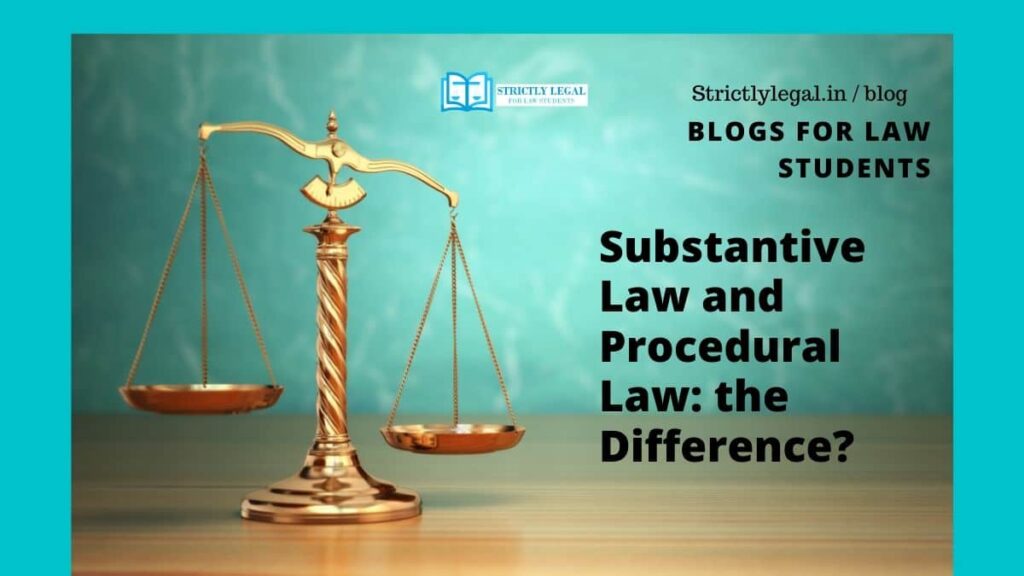In this article, we will discuss the meaning of Substantive Law and law of procedure. We will look for similarities and also figure out where they overlap or are difficult to distinguish.
Law has to play an important role in the administration of justice. It has a dual role to play in the attainment of justice. Firstly, it determines the rights the breach of which can be remedied by legal procedure, and secondly, it lays down the procedure for enforcement of legal rights. From this point of view, the law may be either substantive or procedural. Substantive law is that which defines the rights and remedies while procedural law defines the process through which the remedies can be attained.
Procedural Law Meaning
Procedural law is also called “law of action”. It is that branch which governs the process of litigation. The term ‘action’ in its widest sense includes legal proceedings both civil and criminal.
According to the Common Law Procedure Act,1854 (UK ACT) the word ‘procedure‘, denotes in its larger sense, “the mode of proceeding by which a legal right is enforced, as distinguished from the law which gives or defines a right, and which by means of the proceeding of the Court is to administer the machinery as distinguished from the product”. (Poyser v Minors (1881) LR 7 QBD 329).
In simple words, the procedure prescribes all the steps that must be taken in order to set in motion the machinery of law Courts for the adjudication of disputes between the parties.
The rules of procedure occupy an important place in the administration of justice by law Courts. These rules, like those of substantive law, are primarily applicable to the persons concerned with the justice system administration, whether it be civil, criminal justice as also the parties concerned.
Broadly speaking, the law of procedure comprises the rules relating to (i) jurisdiction of the Court, (ii) proceeding in the Court, (iii) issue of processes (summons, warrants, etc.), (iv) pleadings, (v) trial procedure, (vi) recording of evidence, (vii) appearance of parties, advocates, prosecutors, etc., (viii) judgment of the Court, (ix) Costs, (x) review, revision, appeals, etc. and finally, the execution of decree/order or punishment in criminal cases.
Procedural law distinguished from substantive law

Unlike the procedural law which governs the process of litigation, substantive law is concerned with the ends which the administration of justice seeks to achieve. Procedural law deals with the means and procedure by which those ends can be achieved. In other words, it regulates the conduct and relations of courts and litigants in respect of judicial proceedings. The substantive law, on the other hand, determines their conduct and relation in respect of the litigation of the matter.
According to Salmond, the procedural law can be distinguished from substantive law on the following grounds.
- Substantive law determines the conduct and relations of the parties inter se in respect of the matter litigated whereas the procedural law regulates the conduct and relations of courts and litigants in respect of litigation
- Substantive law deals with the ends which the administration of justice contemplates while procedural law deals with the means and instruments by which the end of the administration of justice is to be attained.
For example, the question that a person has a right to recover certain property pertains to substantive law because the protection of such a right is among one of the ends of justice but in what court and within what time the proceedings should be instituted is a question of procedural law.
- The question as to what facts constitute a wrong is determined by the substantive law while what facts constitute proof of wrong is a question of procedure
- Substantive law defines the remedy and the right, whereas the law of procedure defines the modes and conditions of the application of one to the other.
- Substantive law related to matters outside the courts whereas the procedural law regulates affairs inside the courts.
Despite the above distinction, it is not wholly correct to say that substantive law defines the rights while the procedural law determines the remedies. There are many rights that pertain to the sphere of the procedure.
For example, a right of appeal, a right to interrogate the opposite party, a right to give evidence on one’s own behalf, etc. Conversely, there may be certain rules determining remedy which may be a part of substantive law. For instance, the rules determining classes of agreements which shall be specifically enforced are clearly substantive in nature. Again, the substantive part of the criminal law deals, not with crimes alone, but punishments as well. In civil law, rules, as to measure of damages and power to recover them, are in the nature of remedial rights and pertain to the sphere of substantive law.
It must be stated that most part of the Code of Criminal Procedure and the law of Evidence pertains to procedural law whereas the Indian Penal Code, the law of contract, transfer of property, negotiable instruments, etc. are the examples of substantive law. Again, company law is generally regarded more a substantive law though it has so much of procedure in it since it contains the procedure for formation and management of companies, mode of increasing reducing or reorganization of share capital, the procedure for company-meetings, Mergers, Acquisition, and amalgamation, winding up, etc.
The first part of the Code of Civil Procedure is merely related to the substantive law as it contains the general principles of the law. The second part consisting of orders, however, pertains to procedural law as it relates to the procedure of civil proceedings.
Salmond specifically refers to three instances where the rules of procedure which, in their operation, are wholly or substantially equivalent to rules of substantive law. It is for this reason he says that the difference between substantive law and procedure law is one of form rather than of substance. A rule falling in one category may, by a change in form, pass over into another without materially affecting the practical issue.
These instances are –
- There is a rule of evidence that in order to prove a contract, it must be in writing. This corresponds to the rule of substantive law that a contract is void unless it is reduced in writing. Thus in the former, the writing is the exclusive evidence of title while in the latter, writing is a part of evidence itself. Therefore, is it evident that the distinction is one of form rather than of substance
- Again, all conclusive presumptions pertain in the form of the procedure, but in effect, they constitute the substantive part of the law. For example, the evidence that a child below the age of seven is doli incapax, i.e., incapable of criminal intention, is a part of the law of procedure but it differs only in form from the substantive rule that no child under that age is punishable for an offence.
To cite yet another example, originally, a bond was considered as conclusive proof of the existence of the debt but now it is considered to be creative of a debt. Thus its form has transformed from procedural law to substantive law.
- It has been said that limitation of actions is procedural equivalent of the right of prescription which is a subject-matter of substantive law. The law of limitation which pertains to procedural law destroys the bond between right and remedy whereas the right of prescription, which is its substantive equivalent, destroys the right itself. Thus in their practical application the effect of both is same although they differ in their forms.
The rules of pleading and the law of evidence constitute the most important branches of procedural law. The rules of pleading must be followed by parties to make out their case before the court of law so as to enable the court to decide the case. The law of evidence contains the rules by which the proof of disputed facts is governed. Thus these two have a major role to play in enabling the courts to decide cases.
It is significant to note that where procedural law differs from the substantive law, the latter shall prevail over the former because the procedural law deals with the form and not with the substance or the spirit of the law. The law courts would always look to the spirit of the law and may even go beyond the procedural law for this purpose if so required. Further, there can be no estoppel against the statute and the rule of estoppel would not be allowed to prevail over the provisions of the substantive law.
Here’s a list of both “substantive laws” and ” Procedural laws”. However, this list is not exhaustive and only indicative of a few:
| Substantive law: | Procedural laws |
|---|---|
| The Hindu Marriage Act, 1955. | Code of Civil Procedure, 1908 |
| The Indian Contract Act, 1872. | Code of Criminal Procedure, 1973 |
| The Hindu Succession Act, 1956. | Law of Evidence, 1872 |
| The Transfer of Property Act, 1882. | The Limitation Act, 1963 It should be noted that the Delhi High Court held in NNR Global Logistics (Shanghai) Co Ltd v Aargus Global Logistics Pvt Ltd that the Law of Limitation is a procedural law rather than a substantive law. |
| The Factories Act, 1948. | |
| The Law of Torts. | |
| Industrial Disputes Act, 1947. | |
The obligation to file income tax after a certain threshold is a substantive law whereas the process of filing income tax in the appropriate form and office as has been laid down in the rules is the procedural law.

Users not registered with Strictlylegal can Email us their content and the same are posted through this account. In case of abuse, kindly let us know at [email protected]





Very good post. I’m experiencing some of these issues
as well..